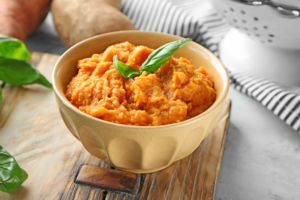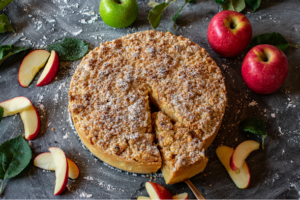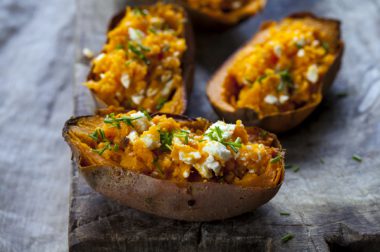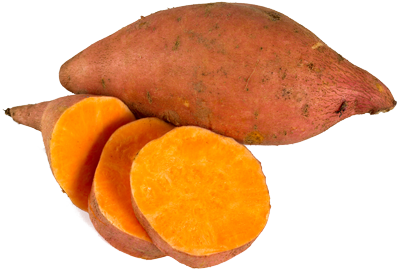Recipes we love
See all recipes
Sweet potato mash
Sweet potatoes can be a great source of provitamin A, depending on the colour of the flesh. The more...

Apple and sweet potato cake
The addition of sweet potato and apple helps to reduce some of the fat that you may normally consume...
Health
benefits
A feast for the eyes !
Sweet potatoes are an excellent source of provitamin A, or beta-carotene. They more colorful they are, the more provitamin A they have. This nutrient is vital for tissue health, immunity, growth, and night vision.
Sweet potatoes are: a source of potassium (for the nervous system, muscular function, and blood pressure)
They also contain:
- vitamin C (multifunctional vitamin: nervous system, skin, energy metabolism, immunity)
- vitamin B6 (energy metabolism, nervous system)
- vitamin B9 (cell renewal, very important for pregnant women for fetal development, for growing children, and for people who are convalescing)
- copper (energy metabolism, nervous system, immunity, etc.)
- manganese (energy metabolism, bone health, antioxidant)
- numerous antioxidants (polyphenols), often most abundant in the skin.
Sweet potatoes are richer in starch than potatoes (up to 18% in some varieties) but still contain the same amount of carbohydrates.
Nutritional
composition
When is the right
time to eat them?
Summer and fall
In the Mediterranean region, sweet potatoes are harvested at the end of summer and in early fall. Imported sweet potatoes are available year-round.
Vegetable patch or
urban balcony?
Sweet potatoes are perennials that grow well in full sun, in drained, sandy soil rich in humus. Soil with a neutral pH (pH = 7) favors proper development for the plant. This vegetable generally grows in hot regions.
To learn everything you need to know about growing sweet potatoes, read the page on growing advice.
Choosing and
storing sweet potatoes
Choose your sweet potatoes well:
- Weight is a determining factor. Sweet potatoes should be heavy and firm, odorless and without spots.
- Choose darker sweet potatoes, which are richer in antioxidants.
Properly store your sweet potatoes:
Like potatoes, sweet potatoes should always be stored in a dark, dry place. However, they are more fragile and last for a shorter time, only seven to ten days.
Anti-waste tips
Do have some sweet potatoes left over? Give them a new life as a pancake, veggie burger or falafel!
And don’t throw away the peel! You can use it to make delicious chips for a snack. Wash the peel well, dry it and place on a baking sheet, baste with olive oil using a brush, add a little bit of chili powder, and put in the oven to crisp up!
What is the environmental impact?
The Product Environmental Footprint (PEF), a score established by Agribalyse*, tells us more! It takes account of all the phases in a vegetable’s life cycle: how it’s grown, the impact of its transport, the impact of its processing, and so on. The lower the score, the lower the environmental impact.
Sweet potato, raw: 0.06
Sweet potato, cooked: 0.12
Steak, raw: 2.77
*Data taken from the Agribalyse database, which gives the environmental score of foodstuffs. This unique score is the average of 16 indicators, calculated using the European methodology PEF. It is not the same as an environmental label or “eco-score”.
CO2 Equivalent: for 100g of raw yam: 0.036 kg of CO2 eq, which is the same as 1 g of raw steak or driving 144 m in a car
Tips and
tricks
How to cook sweet potatoes
Peel them like potatoes. Their flesh will turn brown quickly. Put them into cold water right away to protect them until use.
Cooking times:
- 15-20 min: in salted, boiling water
- 45 min: in the oven
- 30 min: cooked in their skin in the oven
- 15 min: steamed
- 5 min: in the deep fryer
Did you know? You can eat sweet potato leaves! They are prepared like other leafy vegetables (spinach, sorrel, Swiss chard, etc.)
Sweet potato jelly is an Argentinian specialty that closely resembles quince jelly. Sweet potato jelly is often used like chutney, as a condiment for savory cold meats.
Sweet potatoes go well with…
Sweet potatoes can be prepared in the same ways as potatoes. They cannot be eaten raw. With their sweet flavor, sweet potatoes can be used to make sumptuous desserts (cakes, biscuits, crêpes, and more).
Fries: Slathered in oil and fine herbs, then roasted in the oven, sweet potatoes make a surprising, delicious, and colorful version of fries, delicious as a side with fish, and will be sure to please everyone! Sweet potato puree also goes perfectly with fish.
Sweet potatoes also go well with endives, smoked salmon, shellfish, citrus fruits, and more.
They are an essential vegetable in the cuisine of the West Indies, in soup with carrots and ginger, for example.
Discover a vegetable that is rich in starch, and that in reality is a fruit: plantain
Can everyone
eat them?

Young children
It is child’s play to get children to try sweet potatoes starting at six months, because of the vegetable’s sweet taste.
And everyone else
There is no risk for intolerance associated with sweet potatoes, which can be eaten at any age.
See plenty of other tips for encouraging children to eat vegetables
Where do they come from?
Origins and varieties
Origins
This tuber, native to Central America, is not related to potatoes, despite popular belief. The bell-shaped flowers indicate that it is more closely related to other plants with this characteristic, plants in the Convolvulaceae family, such as morning glories. Today, China, Nigeria, the United Republic of Tanzania, Uganda, Indonesia, Vietnam, and the United States are the biggest sweet potato producers.
A staple in both Asia and Latin America, sweet potatoes are also widely enjoyed in the southern United States. French production remains confidential and is almost exclusively concentrated in the country’s overseas administrative departments in the West Indies.
Varieties
There are over 400 sweet potato varieties, with skins ranging in color from white and yellow to red and purplish, while the inside can be white, yellow, or orange. Sweet potatoes can be divided into two categories, moist and dry.
- Moist sweet potatoes are mainly eaten in North America and Europe. They are sweeter, orange in color on the inside, and become softer when cooked.
- Dry sweet potatoes are more popular in South America, Asia, and Africa. They are whitish or yellowish on the inside, less sweet, and starchier in texture after cooking.



 Celery
Celery  Eggplant
Eggplant  Vegetable garden: growing gherkin
Vegetable garden: growing gherkin 










